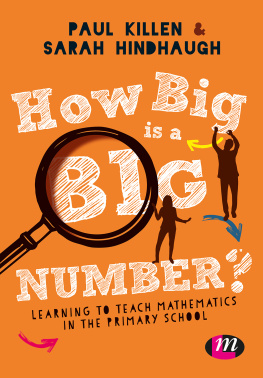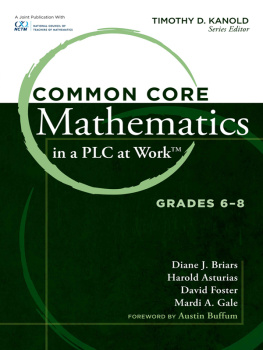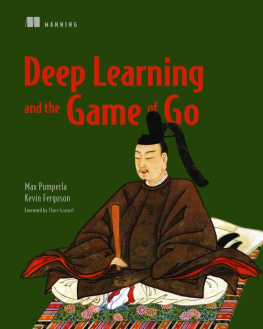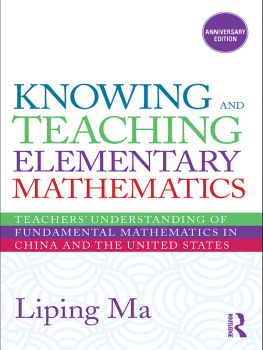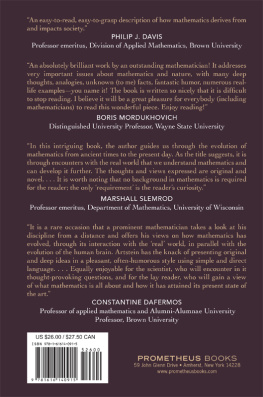Deep Thinking
What Mathematics Can Teach Us About the Mind
Deep Thinking
What Mathematics Can Teach Us About the Mind
William Byers
Concordia University, Canada

Published by
World Scientific Publishing Co. Pte. Ltd.
5 Toh Tuck Link, Singapore 596224
USA office: 27 Warren Street, Suite 401-402, Hackensack, NJ 07601
UK office: 57 Shelton Street, Covent Garden, London WC2H 9HE
Library of Congress Cataloging-in-Publication Data
Byers, William, 1943 author.
Deep thinking : what mathematics can teach us about the mind / William Byers, Concordia University, Canada.
pages cm
Includes bibliographical references and index.
ISBN 978-9814618038 (pbk. : alk. paper)
1. Creative thinking. 2. Thought and thinking. 3. Mathematics--Philosophy. I. Title.
BF408.B94 2014
152.4'2--dc23
2014025869
British Library Cataloguing-in-Publication Data
A catalogue record for this book is available from the British Library.
Copyright 2015 by World Scientific Publishing Co. Pte. Ltd.
All rights reserved. This book, or parts thereof, may not be reproduced in any form or by any means, electronic or mechanical, including photocopying, recording or any information storage and retrieval system now known or to be invented, without written permission from the publisher.
For photocopying of material in this volume, please pay a copying fee through the Copyright Clearance Center, Inc., 222 Rosewood Drive, Danvers, MA 01923, USA. In this case permission to photocopy is not required from the publisher.
Printed in Singapore
Dedication
Thanks to my children Michele and Joshua and especially to my wife Miriam for their help and encouragement. Thanks also to Krista Heinlein Byers for suggesting I read Susan Carey and to Albert Low for suggesting I think about learning.
Contents
Preface: Smart People or Smart Machines?
It takes smart people to produce smart machines. But people smart is not necessarily the same thing as machine smart. Is the intelligence of a driverless car the same as the intelligence of the person who created the software that drives the car? Certainly there is a difference but is this difference qualitative or quantitative? If it is quantitative, a matter of computing power, analytics, and big data, then we will one day share our world with sentient robots. However if the difference is qualitative, and I believe that it is, then human intelligence is in a different league from machine intelligence. The difference between the two lies in what this book will call deep thinking. It is my contention that human beingseven childrenare capable of deep thinking and even the most complex machines are not.
Deep thinking is the process that is at the heart of creativity and learning. It has many namesbreakthrough thinking, reframing, and paradigm change. The result of deep thinking is that one comes to see things in a manner that is radically different from the way one previously saw them. Breakthroughs are inevitably difficult to achieve and involve a discontinuity, which is sometimes called the eureka moment. This book uses the subject matter of mathematics to describe what deep thinking is and how it differs from the rule-based thinking that is familiar from logic, mathematical proofs, and computer algorithms. Mathematics is a good vantage point from which to approach questions of thinking, learning, and creativity because (1) it is built-in to our core cognitive systems; (2) it is the language of science and technology; and (3) elementary mathematics is readily accessible to most people.
There is a gapan unbridgeable chasm, reallybetween human mind and machine mind. One way of conceptualizing this gap is to think about the difference between reality and simulations of reality. Any simulation, no matter how brilliant in conception, is qualitatively different from what it simulates. Human intelligence and creativity are primary phenomena that are real and immediate, whereas simulations are not real in the same waythey are secondary phenomena. Simulations arise from applying deep thinking to a real situation that exists outside of and prior to the model. Subsequent workcomputation and the analysis of datais generated within the model. Deep thinking is the process that creates the simulation in the first place.
For example, the basic way to investigate order in the physical world is through the introduction of number. To do so a system must be created, which tells us what a number isthe counting numbers or the real numbers, for example. We could think of number systems as models (or simulations) of number. Such a conceptual system for number, once established, is the context for many possible computations and other uses of analytic thought. The human being produces the system; the machine works inside this system. Of course, many human activities are also carried out within the systemin the system of counting numbers you can add and multiply, and (sometimes) you can subtract and divide. Thus the machine is amplifying one way in which human beings use their minds. However there are other ways to use the mind. This is not obvious to everyone but is of crucial importance to the point of view developed in this book. Deep thinking is not analytic. It is not only involved in the creation of the conceptual system but also in the students re-creation of it.
Deep thinking is a way to talk in concrete terms about the gap between machine and human intelligence. Deep thinking makes most people think of Einstein developing the Theory of Relativity and other revolutionary breakthroughs in science. Yet we can discover the essence of such thinking in infants and young children. In fact a paradigm of deep thinking is the conceptual reframing that occurs when a child moves from the world of counting numbers to the world of fractions. Both of these conceptual systems tell you what a number is but in ways that are substantially incompatible with one another. Looking at things from the perspective of adults, the movement from the former system to the latter may seem natural and simple, but it is actually a major intellectual accomplishment, and as such, a model for deep thinking.
Thus machine intelligence is not human intelligence, machine learning is not human learning. On the one hand this statement is immediate and obvious but, on the other hand, it is profound and has important implications for the relationship between the world of technology and the world of human beings. The task that this book sets itself is to explore the gap between intelligence, learning, and creativity and their simulations. In the process of this investigation we will run across the limits of machine intelligence, thereby preserving a place for what is irreducibly human.
Innovation
The motor that drives the technological world is innovation but groundbreaking innovation does not come out of tweaking ideas with which everyone is familiar. It comes out of deep thinking, that is, creating a totally new framework. Everyone knows that to come up with a brilliant idea one has to think outside of the box but how does one go about doing that? This is one question that the book will address.
Our cultures capacity to sustain innovation and peoples ability to adjust successfully to a world in which change is not only continuous but also accelerating, depends, in my view, on societys ability to conceptualize the difference between machine and human intelligence. This is despite the major strides that have occurred in recent years in robotics and artificial intelligence. In fact it is precisely these advances that make such a discussion vitally important.
Next page


